Urbanization has posed a significant threat to wildlife, with the loss of habitats and food sources forcing many species to adapt to the concrete jungle.
However, with advancements in GPS collar technology, tracking urban wildlife has become easier, enabling scientists and conservationists to collect vital data that can aid in the preservation of these species.
Jump to Section
Advancements in GPS Collar Technology
GPS collar technology has come a long way since its inception in the 1990s. Initially, these collars were bulky and had limited battery life.
Today, however, GPS collars are small, lightweight, and have a battery life that can last for months or even years.
These advancements have made it possible to track wildlife movements with greater accuracy and for more extended periods.
Tracking Urban Wildlife Made Easier
Urban wildlife, such as coyotes, foxes, and deer, are notoriously challenging to track due to their ability to blend in with the urban environment.
However, GPS collar technology has made it possible to track these species’ movements, providing important data on their behavior, habitat use, and population dynamics. This information can aid in the development of conservation plans that can help protect and preserve these urban wildlife populations.
How GPS Collars Help Scientists and Conservationists
GPS collars have revolutionized the way scientists and conservationists study wildlife.
These collars provide a wealth of information on animal behavior, including their movements, habitat use, and interactions with other animals. This data can help scientists and conservationists understand the ecological needs of these species and develop management plans that address these needs.
Innovations in Collar Design and Functionality
New innovations in GPS collar design and functionality have made it possible to collect even more data on wildlife behavior.
For example, some GPS collars now come equipped with accelerometers that can measure an animal’s movement in three dimensions.
This information can provide important insights into animal behavior, such as how they forage for food or how they navigate their environment.
FAQ
How long do GPS collars last?
GPS collars can last for several months or even years, depending on the type of collar and the battery life.
Some GPS collars are designed to last for only a few weeks, while others can last for several years.
Are GPS collars harmful to wildlife?
GPS collars are generally not harmful to wildlife.
However, researchers take care to ensure that the collars are not too heavy or too tight, which can cause discomfort or injury to the animal.
Can GPS collars be used on all types of wildlife?
GPS collars can be used on a variety of wildlife species, including mammals, birds, reptiles, and fish.
However, the size and weight of the collar must be appropriate for the species being studied.
I’m a nature enthusiast and creator of Metro Wilds and have spent years exploring the great outdoors.
With a passion for environmental conservation and sustainability, I have dedicated my career to writing about the beauty and wonders of nature, as well as the threats facing our planet.
Contact me at [email protected] for assistance.





